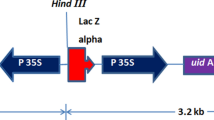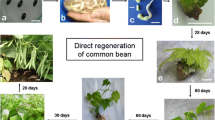Abstract
An Agrobacterium tumefaciens-mediated transformation protocol has been developed for embryogenic cell cultures of Pinus radiata. Transgenic lines were only produced when embryogenic tissue was placed on nurse tissue during the Agrobacterium co-cultivation and recovery stages of the procedure. Plantlets were regenerated via somatic embryogenesis from ten of the 11 transgenic lines tested and at least 20 of each line were planted in a GMO glasshouse. Expression of the nptII, uidA and bar genes in up to ten plants of each individual transgenic line was evaluated by molecular, biochemical and functional analysis. As expected, expression of the nptII gene varied among the ten lines, while within ten replicates of the same line, nptII expression appeared to be consistent, with the exception of one line, K3. Likewise, the level of GUS activity varied among transgenic lines, but was relatively consistent in plants derived from the same tissue, except for two lines, G4 and G5. Moreover, similar absolute values and pattern of gene expression of uidA was observed in the transgenic plants, for two consecutive years. Plantlets from eight lines survived a spray treatment with the equivalent of 2 kg/ha and 4 kg/ha of the commercial formulation Buster, whereas non-transformed controls died. Southern hybridisation analysis of embryogenic tissue and green needle tissue from putative transgenic lines demonstrated a relatively low number of gene insertions (from one to nine) of both the bar and nptII genes in the nine transgenic lines tested.







Similar content being viewed by others
Abbreviations
- bar :
-
Gene coding for phosphinothricin acetyl transferase
- EDM:
-
Embryo development medium
- ELISA:
-
Enzyme linked immuno sorbent assay
- GMO:
-
Genetically modified organism
- MUG:
-
4-Methylumbelliferyl β-d-glucuronide
- nptII/NPTII:
-
Neomycin phosphotransferase gene or protein
- PGR:
-
Plant growth regulator
- PVPP:
-
Polyvinylpolypyrolidone
- uidA/GUS:
-
β-Glucuronidase gene or protein
- SEM:
-
Standard error of the mean
References
Bishop-Hurley SL, Zabkiewicz RJ, Grace LJ, Gardner RC, Wagner A, Walter C (2001) Conifer genetic engineering: transgenic Pinus radiata (D. Don) and Picea abies (Karst) plants are resistant to the herbicide Buster. Plant Cell Rep 20:235–243
Cerda F, Aquea F, Gebauer M, Medina C, Arce-Johnson P (2002) Stable transformation of Pinus radiata embryogenic tissue by Agrobacterium tumefaciens. Plant Cell Tissue Organ Cult 70:251–257
Charity JA, Holland L, Donaldson SS, Grace LJ, Walter C (2002) Agrobacterium-mediated transformation of Pinus radiata organogenic tissue using vacuum infiltration. Plant Cell Tissue Organ Cult 70:51–60
Church GM, Gilbert W (1984) Genomic sequencing. Proc Natl Acad Sci USA 81:1991–1995
Côté C, Rutledge R (2003) An improved MUG fluorescent assay for the determination of GUS activity within transgenic tissue of woody plants. Plant Cell Rep 21:619–624
Dai S, Zheng P, Marmey P, Zhang S, Tian W, Chen S, Beuchy RN, Fauquet C (2001) Comparative analysis of transgenic rice plants obtained by Agrobacterium-mediated transformation and particle bombardment. Mol Breed 7:25–33
Dean C, Jones J, Favreau M, Dunsmuir P, Bedbrook J (1988) Influence of flanking sequences on variability in expression levels of an introduced gene in transgenic tobacco plants. Nucleic Acids Res 16:9267–9283
Ellis DD, McCabe DE, McInnis S, Ramachandran R, Russell DR, Wallace KM, Martinell BJ, Roberts DR, Raffa KF, McCown BH (1993) Stable transformation of Picea glauca by particle acceleration. Biotechnology 11:84–89
Gallagher SR (1992) GUS protocols: using the GUS gene as a reporter of gene expression. Academic, San Diego, Calif.
Hajdukiewicz P, Svab Z, Maliga P (1994) The small, versitile pPZP family of Agrobacterium binary vectors for plant transformation. Plant Mol Biol 25:989–994
Hargreaves CL, Grace LJ, Holden GD (2002) Nurse culture for efficient recovery of cryopreserved P. radiata D. Don embryogenic cell lines. Plant Cell Rep 21:40–45
Hobbs SLA, Warkentin TD, DeLong CMO (1993) Transgene copy number can be positively or negatively associated with transgene expression. Plant Mol Biol 21:17–26
Holland L, Gemmell JE, Charity JA, Walter C (1997) Foreign gene transfer into Pinus radiata cotyledons by Agrobacterium tumefaciens. NZ J For Sci 27(3):289–304
Hood EE, Jen G, Kayes L, Kramer J, Fraley RT, Chilton MD (1987) Restriction endonuclease map of pTiB0542, a potential Ti-plasmid vector for genetic engineering of plants. Biotechnology 2:702–709
Horsch TB, Jones GE (1980) A double filter paper technique for plating cultured cells. In Vitro 16:103–108
Jefferson A, Kavanagh A, Bevan W (1987) GUS fusions: glucuronidase as sensitive marker in higher plants. EMBO J 6:3901–3907
Klimaszewska K, Lachance D, Pelletier G, Lelu M-A, Séguin A (2001) Regeneration of transgenic Picea glauca, P. mariana and P. abies after cocultivation of embryogenic tissue with Agrobacterium tumefaciens. In Vitro Cell Dev Biol Plant 37:748–755
Klimaszewska K, Lachance D, Bernier-Cardou M, Rutldege RG (2003) Transgene integration patterns and expression levels in transgenic lines of Picea mariana, P. glauca and P. abies. Plant Cell Rep 21:1080–1087
Le VQ, Belles-Isles J, Dusabenyagasani M, Tremblay FM (2001) An improved procedure for production of white spruce (Picea glauca) transgenic plants using Agrobacterium tumefaciens. J Exp Bot 364:2089–2095
Levée V, Lelu M-A, Jouanin L, Cornu D, Pilate G (1997) Agrobacterium tumefaciens-mediated transformation of hybrid larch (Larix kaempferi × L. decidua) and transgenic plant regeneration. Plant Cell Rep 16:680–685
Levée V, Garin E, Klimaszewska K, Séguin A (1999) Stable genetic transformation of white pine (Pinus strobus L.) after cocultivation of embryogenic tissues with Agrobacterium tumefaciens. Mol Breed 5:429–440
Makarevitch I, Svitashev SK, Somers DA (2003) Complete sequence analysis of transgene loci from plants transformed via microprojectile bombardment. Plant Mol Biol 52:421–432
Matzke MA, Matzke AJM (1995) How and why do plants inactivate homologous (trans)genes? Plant Physiol 107:679–685
Niu X, Li X, Veronese P, Bressan RA, Weller SC, Hasegawa PM (2000) Factors affecting Agrobacterium tumefaciens-mediated transformation of Peppermint. Plant Cell Rep 9:304–310
Shelbourne CJA, Carson MJ, Wilcox MD (1989) New technologies in the genetic improvement of radiata pine. Commonw For Rev 68:3
Smith D (1996) Growth medium. US patent no 5,565,355
Tang W, Newton RJ (2003) Genetic transformation of conifers and its application in forest biotechnology. Plant Cell Rep 22:1–15
Trontin J-F, Harvengt L, Garin E, Lopez-Bernaza M, Arancia L, Hoebeke J, Canlet F, Pâques M (2002) Towards genetic engineering of maritime pine (Pinus pinaster Ait.). Ann For Sci 59:687–697
Vaucheret H, Béclin C, Elmayan T, Feuerbach F, Gordon C, Morel JB, Mourrain P, Palauqui JC, Vernhettes S (1998) Transgene-induced silencing in plants. Plant J 16:651–659
Veluthambi K, Jayaswal RK, Gelvin SB (1987) Virulence genes A, G, and D mediate the double-stranded border cleavage of T-DNA from the Agrobacterium Ti plasmid. Proc Natl Acad Sci USA 84:1881–1885
Walter C, Grace LJ (2000) Genetic engineering of conifers for plantation forestry: Pinus radiata transformation. In: Jain SM, Minocha SC (eds) Molecular biology of woody plants, vol 2. Kluwer, Dordecht, pp 79–104
Walter C, Grace LJ, Wagner A, White DWR, Walden AR, Donaldson SS, Hinton H, Gardner RC, Smith DR (1998) Stable transformation and regeneration of transgenic plants of Pinus radiata D. Don. Plant Cell Rep 17:460–468
Walter C, Grace LJ, Donaldson SS, Moody J, Gemmell JE, van der Maas S, Kvaalen H, Lonneborg A (1999) An efficient Biolistic transformation protocol for Picea abies embryogenic tissue and regeneration of transgenic plants. Can J For Res 29:1539–1546
Walter C, Bishop-Hurley S, Charity JA, Find J, Grace LJ, Hoefig K, Holland L, Moeller R, Moody J, Wagner A, Walden A (2001) Genetic engineering of Pinus radiata and Picea abies, production of transgenic plants and gene expression studies. International Wood Biotechnology Symposium, Narita, Japan, March 2001
Wenck AR, Quinn M, Whetten RW, Pullman G, Sederoff R (1999) High-efficiency Agrobacterium-mediated transformation of Norway spruce (Picea abies) and loblolly pine (Pinus taeda). Plant Mol Biol 39:407–416
Acknowledgements
We would like to acknowledge funding for research from the New Zealand Forestry Consortiums, Geenz Ltd and LAG and the Foundation for Research, Science and Technology of New Zealand. Technical assistance was provided by Mrs Barbara Geddes, Ms Karen Hignett, Mr Kevin Steele, Mrs Cathie Reeves and Mrs Susan van der Maas. We thank North Carolina State University for the permission to use EHA105 pTOK47. The contribution of Crop and Food Research in finalising the construction of pGUL and pKEA is acknowledged, as is the permission to use the vectors in this research programme. NPTII ELISA and GUS fluorometric analysis was assisted by Mrs Tomoko Pearson, Mrs Judy Moody, Miss Nicola Moore and Mrs Megan Skiffington. We are grateful to Miss Lorelle Phillips for assistance with extraction of DNA, Dr Karen Nielsen and Miss Carmella Lee for assistance with probing the Southern blots. We would also like to thank Dr Phillip Wilcox for statistical analysis, Prof. Richard Gardner for his advice and guidance, as well as Dr Krystyna Klimaszewska and the three anonymous reviewers for critical review of the manuscript. Mrs Bev Harniss and Mrs Tania Elder are gratefully acknowledged for preparing the manuscript for publication.
Author information
Authors and Affiliations
Corresponding author
Additional information
Communicated by S.A. Merkle
Rights and permissions
About this article
Cite this article
Charity, J.A., Holland, L., Grace, L.J. et al. Consistent and stable expression of the nptII, uidA and bar genes in transgenic Pinus radiata after Agrobacterium tumefaciens-mediated transformation using nurse cultures. Plant Cell Rep 23, 606–616 (2005). https://doi.org/10.1007/s00299-004-0851-6
Received:
Revised:
Accepted:
Published:
Issue Date:
DOI: https://doi.org/10.1007/s00299-004-0851-6




